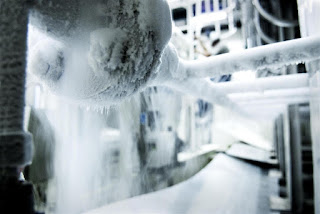From the
physics standpoint, cryogenics is the study of the production and behavior of
materials at very low temperatures. However, there are many sub branches of
cryogenics. Cryobiology is the study of how the effects of low temperatures on
organisms. The easiest way to describe cryobiology is to point people in the
direction of Star Wars Episode V where Darth Vader has Han Solo frozen in
substance called Carbonite that freezes him in an instant. Han was lucky to
have survived the freezing. Cryonics, comes back to another sci-fi style of
science in where humans or organisms are preserved using cryogenic methods,
only to be revived in the future. A great example of this can be seen in the
first Halo video game or read about in the novels. Cryosurgery is the study of
applying incredibly low temperatures to destroy malignant tissue, like tumors.
Finally, cryoelectronics is the study of superconductivity at low temperatures.
Many people
think that Dry Ice is considered cryogenics, but this is not the case. It is
how ever couple with cryogenics due to properties of Dry Ice. Cryogens are
substances that are used to produce temperatures that are below -153 degrees
Celsius or -243 degrees Fahrenheit. A person who studies these elements and
that has been exposed to extremely cold temperatures are referred to as a
cryogenist. What Dry Ice will do is convert directly from a solid carbon
dioxide to a carbon dioxide gas. This process will go at a rate of five to ten
pounds every 24 hours, so it would be a good idea to pick up Dry Ice as close
to the time its needed as possible. Dry Ice is often used in laboratories and
shipments, so reviewing the hazards of cryogenics apply to it as well.
Safety
hazards associated with the use of cryogenic include cold contact burns,
asphyxiation, explosion, pressure problems, or even chemical. Cold contact
burns occur when the low temp liquid or gas produce an effect similar to that
of a burn. Asphyxiation can occur due to the displaced oxygen in the
environment due to the cryogens. Oxygen content when dealing with cryogens
should be close to 22% by volume, but if that value drops to 18%, noticeable
effects can occur. Around 6% oxygen volume will result in sudden death. When it
comes to cryogenics, explosions are caused by pressure when the heat flux into
the cryogen from the environment will vaporize the liquid and cause a potential
build up of pressure. In order to counter this, adequate pressure relief needs
to be provided to all parts of a cryogenic system to permit the routine
outgassing to prevent the build up of pressure and potential explosion.
Chemical explosions occur when the cryogenic fluids with a lower boiling point
than that of liquid oxygen condense the oxygen from the atmosphere. This will
lead to an oxygen enrichment, in which violent reactions and rapid combustion
or an explosion may occur if the material comes into contact with the oxygen.


No comments:
Post a Comment
Note: Only a member of this blog may post a comment.